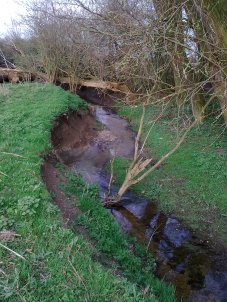November 28, 2010. Late morning. Cold, clear and sunny. No snow last night, but a very heavy frost. A sparkling high-definition winter’s day, with everything at its sharpest and most intensely coloured. The horse pasture below the church is a white sheet of crystals. A jay flies low and settles on the ground. Not often encountered this year, though for the past week or so a pair has visited the garden, ever-wary and off at the slightest of movements. This must be one of them. The light is behind me and for the first time I see its true colours – both deep and pale pink, black and white, and that flash of sky in the wing, a pure azure more perfect in blueness than all other blues.
Beck brook is partially frozen over, as translucent and flawed as old glass. The feeder from Histon is sealed across, though further up, a clear stream of water flows between shelves of white ice. On the ground each blade of grass is a colony of towering crystals, and each leaf a crisp, curled shard of colour that shatters under the boot. Beyond the brook, in the middle of a winter-wheat field, the green just breaking through, is a solitary little egret, slender and white, hunched at the shoulder, standing on one thin black leg in the sun. Perfectly still, it doesn’t even swivel its head or long bill, as if frozen solid. Last seen, in this same vicinity, in early June. An hour later, when I have looped around, it passes overhead, towards the north, long neck tucked back, legs and yellow feet stretched out behind. It flies on stiff concave wings, never straightening or flexing them, holding the curve of the air. That each species has its own distinctive wing movement and flight pattern, as one would expect, is still endlessly fascinating, still wondrous to me.
In the patch of woodland along the brook, blackbirds aplenty scuffle through litter, and fly off with a protest into the undergrowth. There is a steady, slow-motion falling of leaves from above, a reluctant descent of minerals through air, from field maples and oaks. A couple of squirrels, in different locations, retreat to the biggest trees and eye me from on high, their thick, soft tails arched forward over their backs. I am on the lookout now for our local tribe of black melanistic squirrels, though these two show no sign of the tarbrush. I tarry for some time at the brook where it curves round to pass under the road-bridge. The sun has brought out the birds. On the bankside, robins, blue tits, great tits, blackbirds, and a solitary redwing, with blushed flanks and a striking pale supercilium through the line of the eye, pass back and forth over the water, here clear of ice. These last are usually highly gregarious. A moorhen picks through the shallows. The clear light transforms this sombre, uniformly dark bird into a creature extraordinary, for it is exquisitely, subtly two-toned – deep grey-black above and paler slate-grey below, separated by a wavy white line; in front, a small red bill, behind, the double white tail, jerking incessantly. Then an unexpected delight. A kingfisher alights on a thin branch arching over the water, as kingfishers do. Facing away from me, I see only the iridescent turquoise-blue back but as it flashes away downstream it reveals its orange-red underparts. A little winged jewel. I’ve not seen one since mid-July.
Walking upstream I put up a male mallard. It flies high in a big sweeping arc and as it turns back towards me, five others, two drakes and three ducks, in tight formation, wing fast overhead in the same direction. It soon catches up with its crew, and off they go, united. A flight of mallard against a big winter sky – what could be more evocative, more symbolic, of an English winter, except perhaps the scent of woodsmoke? A single lapwing flies west on broad rounded wings – strange to see one on its own. Then five minutes later, half a dozen follow suit. Reaching the big fields beyond, hazed green with young blades of wheat, I find dozens more, scattered evenly over a wide area, working the frozen earth. Green-black bodies, white below, with distinctive wispy black crests, they look small against the great expanse. White gulls wheel lazily above, landing occasionally. The hedgerow harbours several dozen fieldfares which abscond one by one as I approach, making small noises of discontent. They keep looping forward into the next tree along, blue-grey and rust-red in flight, flashing white underparts and black tail.
A final epiphany thanks to today’s special light. Woodpigeons, as plump as college porters, sit in a pasture, larger than life, sunbathing. The commonest bird in these parts, easily overlooked, yet in coloration and marking, really quite stunning. That white wing bar in flight, for example. But up close, the degrees of blueness in the greys of head and wing shading into the magenta-pink barrel-chest, the splash of white and shimmer of purple and green on the neck, make this a most handsome bird.






